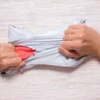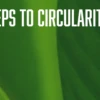Since the adoption of the Circular Economy Action Plan (CEAP) in March 2020, circularity has been a core component of the EU’s Green Deal. The CEAP targets the way products are designed and promotes circular economy practices, with the aim of preventing waste and optimising the use of resources.1 This has been followed by other legislation focused on the fashion industry, such as the Ecodesign for Sustainable Products Regulation (ESPR). This regulation, which came into force in July, introduced a ban on the destruction of unsold textiles and footwear, requiring many brands to rethink their approach to waste.
What does ecodesign mean for your fashion brand?
This ban reinforces the importance of circular business models in the fashion industry. According to the EU, circularity represents a major opportunity for economic development. In announcing the CEAP, the European Commission (EC) cited a study which estimated that applying circular economy principles across the EU economy has the potential to create around 700,000 new jobs and increase GDP by 0.5% by 2030. It also outlined the business case for circular practices, saying that “since manufacturing firms in the EU spend on average about 40% on materials, closed-loop models can increase their profitability, while sheltering them from resource price fluctuations.”2
Circularity can therefore unlock many operational opportunities for brands – and facilitate a closer relationship with customers. So, how do you take your first steps to compliance with regulations like the ESPR? In some countries, national efforts are already helping brands to meet circularity requirements. For example, France’s EPR legislation has been accompanied by the introduction of dedicated producer responsibility organisations (PROs). These bodies help brands to manage the end-of-life stage of products and prevent unsold goods from being sent to landfill. But is there also a role for logistics partners to play in the circularity equation? Below, we look at other ways in which brands can incorporate circularity into their business models.
A practical solution for implementing ecodesign
Many fashion and lifestyle brands that we speak to are keen to adopt more sustainable practices – but where should they start? Often, the best approach is to focus on a specific ‘waste stream’ and find ways to turn waste into value. One waste stream that we’ve been investigating is the damaged returns flow. On average between 2-5% of items returned are considered damaged, and typically end up being discarded. But the good news is that many of these products can be restored to like-new condition.
So, if a brand can implement circular practices structurally in the returns process, it’s a key step on the path to reducing waste and facilitating ESPR compliance. Of course, this requires a streamlined process to ensure that damaged items can be effectively sorted and repaired. Once the garments have been renewed, they can be returned to stock.
This means that brands can extract more value from their products while improving their sustainability and circularity credentials. And Bleckmann’s Renewal Workshop team has already demonstrated the effectiveness of this approach. When we launched a returns repair service for online retailer Otrium, 50% of the damaged goods were rescued, and within 7 weeks, 70% of the repaired goods had been sold again!
What’s your role in the circularity transition?
Of course, implementing circularity requires a harmonised effort across the fashion industry to create more repairable products. That’s why the ESPR includes guidelines for product design that emphasise durability and recyclability. This means consumers will benefit from higher-quality, more sustainable products – and it will be easier to implement circular business models. Through smart collaboration across the value chain, brands and their partners can work together to create a more sustainable industry.
And as more and more solutions to facilitate circular supply chain become available, fashion and lifestyle brands will be much better equipped to navigate the evolving regulatory landscape. For example, the European Commission is planning to introduce a mandatory Extended Producer Responsibility (EPR) policy for textiles across the EU. This aims to reduce textile waste by increasing recyclability and facilitating the reuse of products.
In addition, countries across the EU have enacted legislation to encourage more circular practices. For example, France’s 2020 Anti-waste law promotes the consideration of material recovery at the design stage and encourages reuse.3 Meanwhile, the Dutch National Circular Economy Programme 2023-30 aims to increase high-grade recycling capabilities.4 A 2022 Eurostat study found that the circularity rate (the proportion of material resources used that comes from recycled waste materials) was highest in the Netherlands (27.5%), followed by Belgium (22.2%) and France (19.3%).5
And with even more sustainability-focused initiatives on the horizon, now is the ideal time to develop your brand’s approach to circularity. Partners such as Bleckmann can help you understand your brand’s role in the evolving regulatory landscape and how you can implement plug-in circularity solutions. Importantly, circularity doesn’t have to be a burden for your brand. It can be a valuable next step on the path to sustainable growth.
Want to find out more about how your brand can adapt and thrive in the fashion industry of the future? Get in contact today for a free consultation with a Bleckmann expert.


















